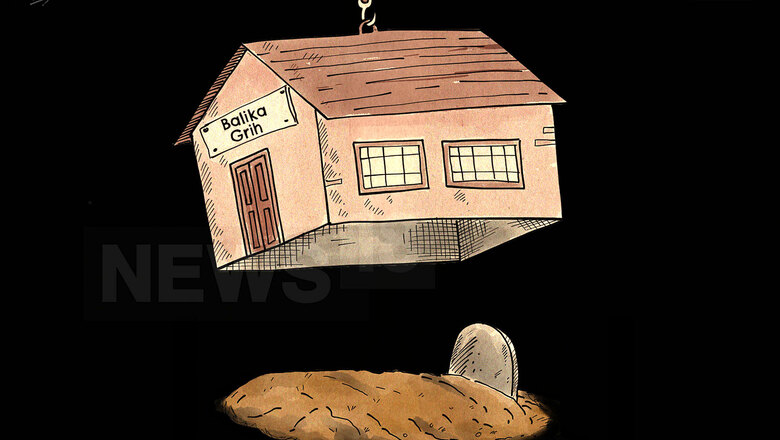
views
New Delhi: It began, as Mohammad Tarique says, with a simple request from a senior bureaucrat. He wanted Tarique and his team to inspect the shelter homes in Bihar to find out which of them require more help from the state and which of them were not following the laid down best practices.
Conducting social audits of hundreds of shelter homes in the country was the-first-of-its-kind project in the country and what Tarique and his team found in their investigations was virtually an industry of shelter homes that was not just confining vulnerable people — the elderly, mentally unsound, women and children. As police found out through its investigations based on Tarique's report, these shelter homes were sexually exploiting young boys and girls, abusing them, murdering them, and in some cases forcing them to take their own lives.
“It was beyond anyone’s imagination,” Tarique says. In a section of the report titled ‘Grave Concerns’ that News18 accessed, these were some of the observations that Tarique and his colleagues made —
‘Abuse, varying in forms and degrees of intensity, was reported to be prevalent in almost all institutions, there were certain institutions that stood out in a manner that was appalling.’
‘Almost all institutions were running in violation of the respective schemes and the essence of juvenile justice act, but the residents’ inalienable right to life was in question in certain institutions.’
‘In Muzaffarpur home [where from a single shelter home reports of rape of up to 40 minor girls is being investigated] the girls had no access to any sort of open space and were literally locked up in their wards except for when they went to the dining hall.’
A short stay home in Patna
‘One of the girls had committed suicide a year ago unable to cope with violent atmosphere of the home. Another girl lost her mental balance from trauma she suffered there.’
In a Boys’ children home in Motihari beating all children was the norm. ‘On the day of visit, all staff members except one person, who could not explain what his role in home, were absent.’ A boys’ home in Bhagalpur narrated a similar story. The children were subjected to grave sexual abuse.
In a boys’ shelter home in Munger
‘They were made to work for the superintendent, cook and clean for him, beaten up if they refused. One of the boys showed a 3 inch long scar across his cheek from the time he was hit when he refused to cook for supervisor.'
In a boys shelter home in Gaya
‘Female staff were forcing boys to write lewd messages on paper.’
Specialised adoption centre in Patna, Madhubani, Kaimur
‘Running in a condition that is likely to be life-threatening for residents.’
In a statement before a judicial magistrate a 10-year-old girl illegally confined in the Muzaffarpur shelter home said she was often drugged before being raped. She would wake up with pain and injury marks on her private parts.
"Nobody was allowed to enter the rooms when tondwala uncleji or Netaji were around," another girl told the magistrate.
The wife of the arrested district child protection officer had alleged that the girls called the state social welfare department minister Manju Verma's husband as Netaji. Minister Manju, who belongs to chief minister Nitish Kumar's party, claims that she was being targeted for her caste.
To understand the scale on which a virtual exploitation industry feeding on young girls and boys has been running in Bihar, News18 interviewed Tarique, the person behind the report. Excerpts.
Where did the idea of auditing shelter homes originate from
The principal secretary of the state's social welfare department expressed his desire to get shelter homes in the state inspected and we explored the idea in detail. We narrowed down two clear objectives in doing this social audit — to find what the government could do to aid the shelter homes that were doing good work but were lacking in some resource, and to find out any malpractices going on in these shelter home.
We first took all the NGO run homes but then the Principal Secretary expressed the wish to audit government run homes also.
So how many shelter homes did you end up auditing?
We audited 110 shelter homes in 38 districts.
And what did you find out?
Physical abuse was there in quite a few institutions. So we referred these cases to the police department. We were not an investigating agency but through our visits we could identify the institutions where we suspected serious human rights violations going on.
This includes the shelter home for girls in Muzaffarpur
Yes, we could sniff very serious sexual abuse going on, but the full scope of the crime that the police has unearthed is quite baffling to us also. It is extremely severe. The brutalities are beyond imagination. We spoke to girls from this institutions and tried to get a sense of the way they were being treated. Some of the girls, who were not directly abused, spoke about it. They were indicating a larger pattern of abuse.
It is only later that we found that a large number of girls had burn and cut marks on their bodies. Even in their private parts. And these injuries were being left untreated. Somebody had slashed their private parts with a blade and said, “This is how you will remember me.” And let us remember these girls are very young from 7 to 15 year olds. The fact that CWC members are involved in this make this particular case all the more horrific.
Why?
Because the CWC people were meant to take care of these girls and boys. They are the ones children could turn to, in case of a crisis, and complain. We do have a system to take care of the children that system is the CWC. It is meant to protect the children and prevent their abuse. This is why this case is all the more serious because CWC members are involved in this. It is scary that a person who holds position of a judge is an accused in a rape case in an institution for which he’s responsible. They are supposed to be guardians of this institutions. Why would any child open up to anyone.
Now if the CWC members are themselves involved do you understand the level of damage it would have caused to the pysche of children. Not just these 40-50 children. Children living in any shelter home. All of them will now identify these people as predators. They will not trust anyone easily now. The higher courts need to deliver an extraordinarily strong, an exemplary punishment to them.
What sort of response have you encountered so far?
All sorts. Some of it is encouraging but a lot of it is unconstructive. A lot of debate and discussion I'm witnessing around seems to be a debate focussed on scoring political points. RJD did this, JD(U) did that.
Who is talking about the welfare of these girls. Can we even imagine the level of trauma they have suffered? What do we do to ensure that they are able to collect themselves and start building their lives again.
We are also missing the larger point about social audits. One officer was ready to take the responsibility and get the institutions audited. He also got in touch with an organisation capable of doing it. But what if he hadn’t done it? Social audit is not part of our monitoring mechanism and it is a very sad thing. Why don’t we make it a permanent fixture?
Also, while every state and party has come out and condemned this brutality, which among them are willing to let us, or any other organisation, audit their shelter homes? Is there any state that can say with confidence that their shelter homes are clean? In our efforts to politicise the issue we are failing our children.
Couldn’t we have found about this earlier?
From these series of incidents we understand that the children became the lowest priority for the system. In the name of inspection, most of the attention was put on documentation, on whether some 15-20 registers that are supposed to be maintained, whether they were maintained. There was little focus on interacting with children.
Documentation shouldn’t have been the benchmark. It should be the rate of rehabilitation. If a child has been in an institution for several years, for me that’s a failure.
So where do we go from here?
First, let us ensure that the users of this system are the ones who evaluate the system. Without their evaluation the funds for these shelter homes shouldn’t be cleared. This is one.
There should be guiding principles for running these institutions — compassion, dignity, freedom. It may not be a fool proof plan but you’ll have train your teams for this. You will be orienting your staff managing these homes with these values.
People running these institutions should know that we are not doing these vulnerable people any favours. As a state you are supposed to be doing this. You are responsible for these people. And let’s not forget that the children, old people or women in distress, all sorts of people who reach these institutions are the most vulnerable population. So being most vulnerable they probably deserve the best of the government, the state and from the society.


















Comments
0 comment